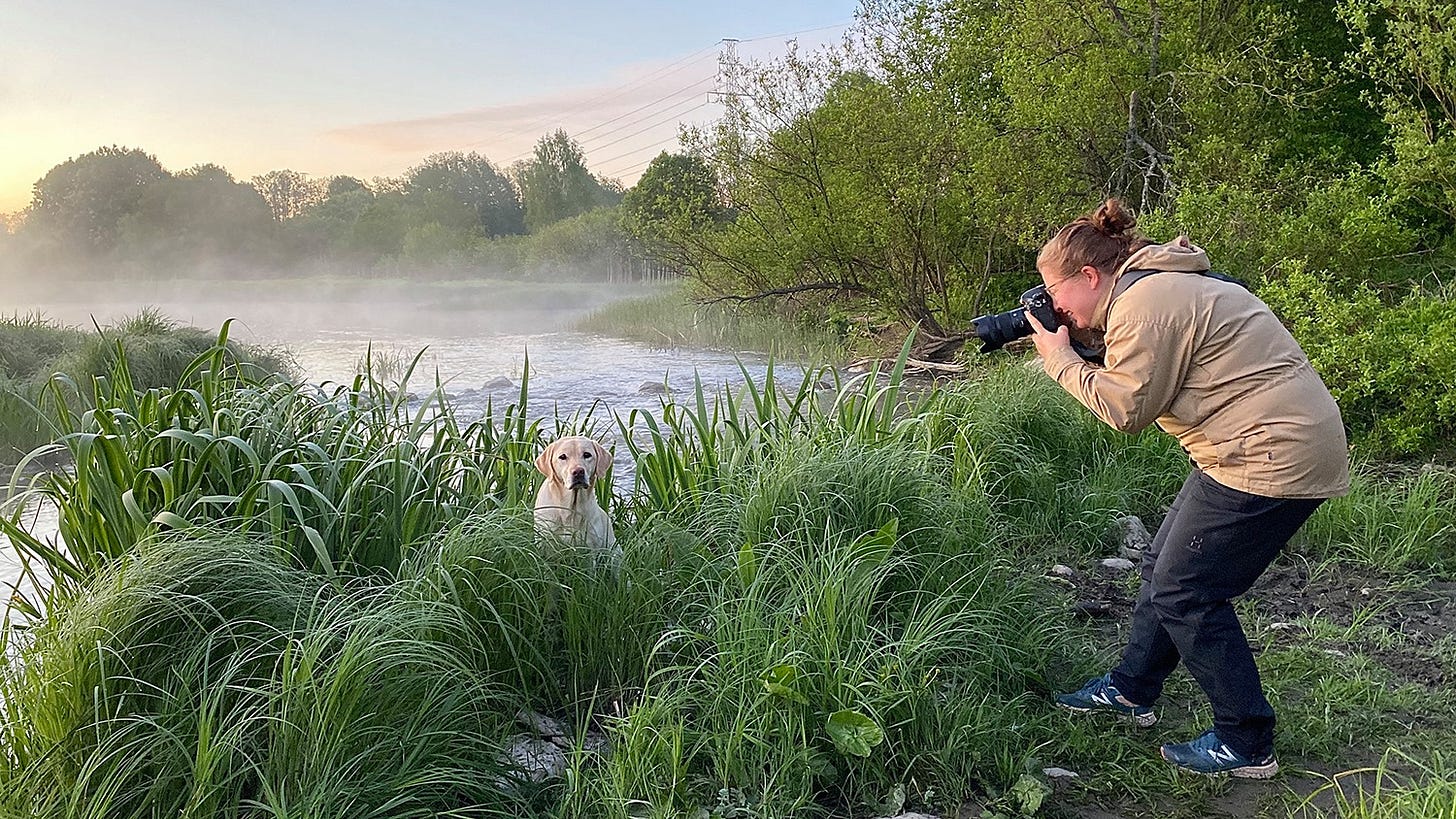My best business tip: Learn the names
Why remembering names is the simplest way to build trust and grow your business?
Dear,
This time, it’s all about business! I’m sharing my best business tip with you, and it won’t cost you a dime.
Thanks for being here.
Cheers!
Nani
If you’re here for the Finnish pieces:
🇫🇮 Voit tilata myös Kaikki taivaan linnut -blogikirjeeni, jossa jaan (lähinnä) Substack-vinkkejä suomeksi. Toimi näin: Valitse tämän kirjeen lopusta Unsubscribe, jolloin päädyt Substackin asetuksiin ja voit hallita tilauksiasi. 🇫🇮
Listen to me read this article:
Even Snufkin knows it
We slumped onto our blue couch1 to read a story about Snufkin’s spring tune. Winter is over, and he’s on his way back to his friends in Moominvalley.
Snufkin sits by the campfire, trying to come up with a melody for his new song. He’s a proper spelman, I must say.
Suddenly, he hears something that stops him in his tracks.
A small creature peers down at him from a tree above. When Snufkin asks for its name, he gets no answer.
Someone with no name? Hmm, that’s a bit strange.
Snufkin knows that everyone needs a name, so he decides to call the creature Teety-Woo. Teety-Woo is delighted—they now have a name.
Later, when Snufkin asks Teety-Woo for a helping hand, the reply is simple: ”I’m sorry, I don’t have time for that now. I have a name.”
You get one day to learn all the names
I learned the importance of using names as part of communication while working at the YMCA.2 Before every summer, we had a couple of kick-off meetings where we went through all the tiny details—but also our values and safety protocols.
During one of these meetings, my boss gave a great speech about the upcoming confirmation camps.3 It went something like this:
Every one of these kids has a name. It can be the same name as someone else’s at camp—we might have five Lauras or three Sammys. They might have a nickname they like, but they might also have one they hate. Our job is to see these kids, to be for them. We call them by their name.
Then, he challenged us to learn all 30 kids’ names by the time the first camp day turned to night.
Life-changing tip
There are only a handful of speeches that inspire action or truly change everyday life.
But when I left my day job in 2012, I clung to this one tip as though my life depended on it. It felt crucial, and I had already witnessed its power during camp life.
And little did I know.
This tip—or the ethos behind it—would become the cornerstone of my photography business at the time, which has since evolved into a broader communications business.
It was hard to make it as a photographer already in 2012. The market, now fully saturated with aspiring photographers, was quickly filling up with a lot of good enough portrait photographers.
I learned a hard truth during my first year: You don’t have to be the best, you just have to be good enough. People don’t buy only the end result—they buy the entire experience. And if that experience resonates with them, they’ll recommend it to their friends.
What do you think: Do people choose a photographer who makes them feel seen and takes good enough pictures, or do they go for someone who doesn’t make them feel… anything?
Since people can’t tell if we’ve spent 2 or 22 minutes editing an image, we need other ways to differentiate our business.
For me, it was leveraging my background and the skills I gained, for example, as a youth worker and a leader of Youth Effectiveness Training (Y.E.T.)4.
I began to refine the way I interacted with potential clients—from the first email to the last one, well after our session. The client experience became my differentiator. I didn’t want to offer a mass-produced service, but to provide an experience that would make them want to come back.
Just like the kids at our camps.

Remember the names, get more gigs
It pays to remember the names.
For example, at weddings, it’s good to make sure you remember the names of the wedding party—especially grandma Jo.5
When you’re doing a B2B shoot, pay attention to everyone who has a role in the process. It’s not about us.
Aaand, in family shoots. Remember the names of every single person in front of your camera, but give your full attention to the tiniest ones—kids and pets.
This is so important, and not just for sales. It’s as much about building trust, slowing things down, and showing you care.
Don’t leave the camera at home (every photographer’s nightmare), but treat it as a tool. The greatest images are born out of trust. When our clients get comfortable in front of our camera, when we manage to make it nice, we see what’s under the skin. Probably a great image.
But it’s not just names. In the end, the names lead me to remember. What was going on in their lives the last time we photographed together? Calling people by their name is a powerful way to improve the customer experience.
Not today, Satan
The history of names and naming children follows us to this day. For example, an old Finnish tradition still lives on.
There was once a belief that if a child’s name was spoken before baptism, the devil might claim the child’s soul. In the pre-Christian era, when Finns believed in spirits and otherworldly forces, it was natural to see baptism as a way to protect the child from the unknown.
Families were very careful not to reveal a child’s name before the baptism ceremony, and they referred to the child using vague terms like “the little one” until the baptism.
You might be surprised, but to this day, many families in Finland won’t reveal the name before the baptism (or the naming party). Not many know the backstory, but many believe that the child gets their name “officially” via baptism.6

“I’m so bad with names!”
I’m good with names, because I’ve practiced so much. But I know it’s a common struggle. You might have a bad memory for names, but could it be that you’re sometimes not paying enough attention?
Anxiety, stress, and rushing can sometimes interfere with our memory. It’s easy to remember 10 new names—or even just 5—if we’re not stressed about the situation we’re in.
But dare I say, not learning names can also result from laziness. If we’re not motivated or interested in the situations we’re in and the people we meet, the names easily slip our minds.
And isn’t it our job to learn the names of the people we work with?
It should be. I think so.
This great video by brain performance coach Jim Kwik offers excellent tips to help you improve your memory for names.
Too American, too American
In 2017-2019, I traveled around Finland giving talks about social selling, with a particular focus on Instagram.
My mantra was simple, and I still use it as a content production principle with my communications clients:
Use a great photo to grab attention, use a compelling caption to connect with your audience, and acknowledge them by answering their comments.
With their name.
When I encouraged the participants in my talks to use the commentator’s name, I received a lot of critique. “It’s so American” (true, it’s not the Finnish way!), “It’s so fake” (true, it’s not the obvious approach!), “It’s too much work” (true, but running a client-based business isn’t about you!).
But it’s incredibly effective. It’s a powerful way to show them we’ve noticed them. And why is that?
Because I believe everyone’s name is their favorite word.7
Show your humanity
I forget about people’s names too.8 It’s not that serious, it’s not embarrassing.
If this happens, I apologize and ask them to repeat it. Then I say:
“Oh, Lisa, yes. Do you spell it with an S or a Z?” or “That is a lovely name. My aunt is your namesake” or “Oh, now I must remember that. Lisa, Lisa, Lisa.”
And then we laugh about it. And then I remember it.
Maybe not forever but as long as my business needs it.

My soon-to-be four-year-old loves our couch more than the Moomins, but he's getting the hang of the trolls too.
I was in my early twenties, studying Theology at university and working part-time as a youth worker with kids aged 7 to 17. During the summers, there were hundreds of kids taking part in YMCA camps.
Lutheran confirmation training is extremely popular in Finland, with well over 80 % of 15-year-old Finns attending the voluntary confirmation classes. Read more
“The purpose of Y.E.T. is to help youth develop themselves socially and emotionally by offering them both basic personal development skills as well as relationship skills—skills they can use in all areas of their lives and for a lifetime.” Source and read more
Pro tip: Ask for a list of all, or at least the most important, guests and their relationship to the couple.
When I was doing my Master’s studies, there was a woman in my group, already in her fifties, who thought that in the Lutheran faith, a child gets their name through baptism. Our professor asked her to get her facts straight.
When my (now almost 4-year-old) kid learned my name, I was over the moon. When he said 'Nani,' it sounded like the greatest poem I’ve ever heard. Of course, when he kept using my name, like 'Good morning, Nani!' it started to sound like I was the evil stepmom. He still plays with my name some days. Such a funny one, he is.
But hey, don’t tell anyone, but one time I forgot what the groom looked like. I had only met him about 10 times before his big day. 🤦🏻 But he looked so different! I was greeting the maid of honor and the groomsmen, who were standing in a row. I went on like, 'Nani, nice to meet you, Tommy. Nani, nice to meet you, Laura. Nani, nice to meet you, Sade.' And then came someone who looked eerily familiar. 'Nani, nice to meet you, Johan.' Yep, it was the groom. And no, I didn’t realize it until 30 seconds later. Why didn’t he say anything? That’s the real question. But the day continued after a hearty laugh.






My 8-year old kid just learned about my middle name, and was horrified: "Mom, that can't be your name! I don't know you anymore!" And it's a really common name. We agreed to never speak that name again :D